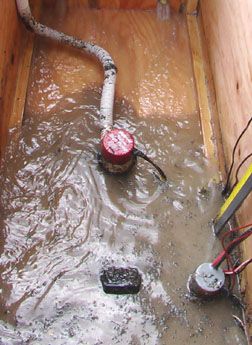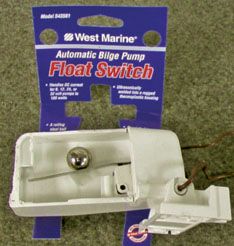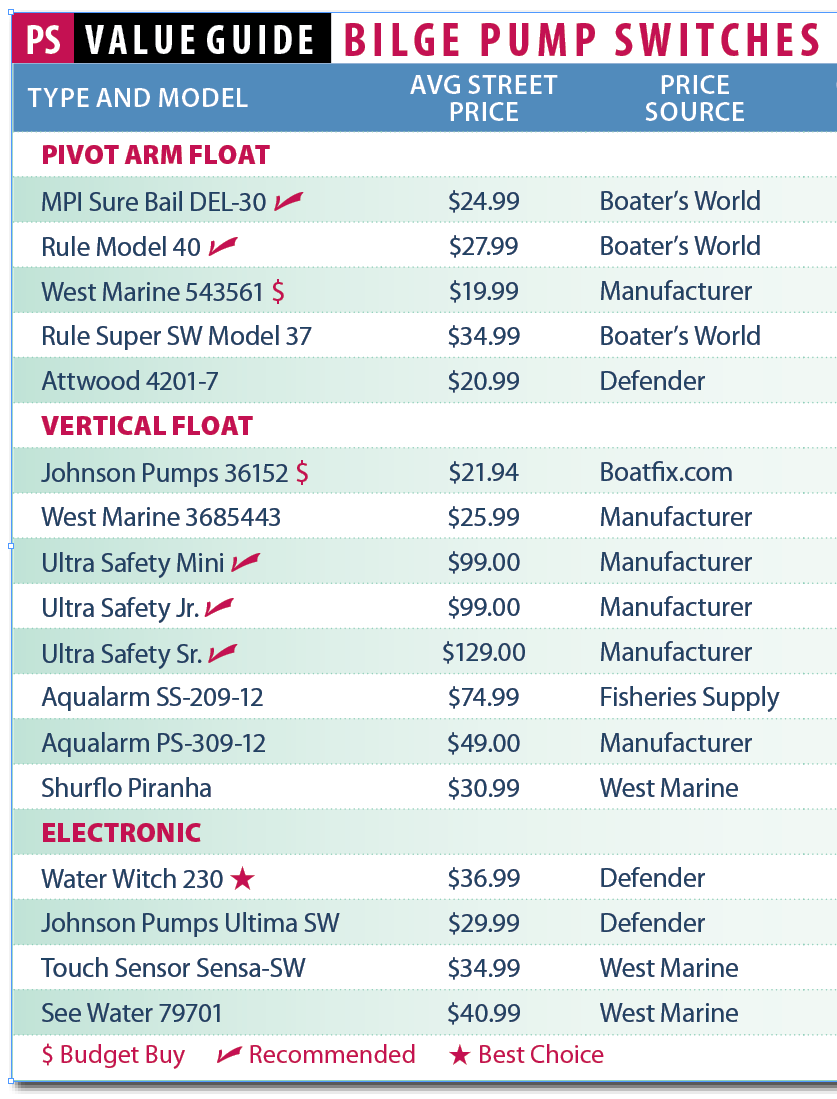
The automatic bilge pump switch is the lowly guardian of our bilge. Its sole purpose: switch the bilge pump on when a predetermined level of water is detected in the bilge, and then turn the pump off when the bilge is dry. The job may sound easy, but sloshing, corrosive seawater, oil, fiberglass shards and other debris typically found in a bilge can foil even the simplest task.
Shopping for the ideal pump switch presents its own sticky challenge. At least 30 different bilge pump switches flood the marine market today.
What We Tested
For this comparison, we kept our focus on stand-alone switches, units that would be suitable companions to the West Marine High Performance 2200 GPH (part #491720), the Shurflo Piranha 1000, the Rule 25D and the Shurflo Piranha 380, the pumps that did the best in our bilge pump comparison (“Electric Bilge Pumps,” February, 15 2004). These types of switches are usually grouped into four basic categories: the pivoting arm, the air pressure, the vertical float, and the electronic pump switch. To preserve the sanity of our tester, we further narrowed the field to 17 switches, so this round of testing did not include the air pressure type, which we’ll look at in a later article.
Because each type of bilge switch has its drawbacks, a cruising sailor who is serious about having a failsafe system to keep out bilge water should consider two completely independent pumps (including independent hose runs and wiring), activated by distinct types of switches.
Pivoting Arm Float
This is the simplest type of switch on the market. As the bilge water rises, the pivoting arm floats up and closes the switch circuit (continuity) at a preset level.
Pros: The low-tech design makes it the least expensive. Testing is usually simple: lift the float and see if your pump works. Installation is a snap.
Cons: It requires flexible, smaller diameter wiring (usually 16-18 gauge) that limits the switch’s maximum amperage capacity and increases the likelihood of failure. Float switches are prone to excessive pump cycling as water surges through the bilge.
Bottom line: This type is best suited for narrow bilges or sumps where surge is not an issue, and it will serve well as an inexpensive backup or secondary switch. A robust one, like the Sure Bail, is a perfect fit for those who favor simplicity.
Vertical Float Switches
This design features a vertical guide tube that is fitted with a life ring-style float, embedded with a small magnet. As the bilge water rises, the ring floats up the guide tube, and the magnet inside activates a micro-switch located in a separate watertight compartment in the unit’s case.
Pros: The vertical switch promises a longer life cycle because the circuit connection is made via a magnetic reed switch, similar to wired door sensors found on most residential home security systems.
Cons: Added complexity can be a drawback with any mechanical system trying to survive the bilge. Inspection and manual testing is difficult on some units.
Bottom line: If sloshing water is causing false pump cycling and you’re skeptical of electronic switches, then an upgrade to a vertical float like the Johnson Electronic Switch (part #36152) or its twin, the West Marine Magnum (part #3685443), or it) might be in order. For an industrial strength switch (at an equally hefty pricetag), pick one of the switches from Ultra Safety Systems.
Electronic Switches
All switches we tested of this type used either capacitance sensors or Mirus field technology. In a capacitance sensor, the switch is activated by changes in capacitance when water is present. In Mirus field technology, a sensitive micro-electrical field within the switch is disrupted when water touches it, activating the pump.
Pros: Completely sealed and with no moving parts, these switches shouldn’t fail. Internal microprocessors can delay pumping to counteract surging, and extend pumping to better purge a pump’s hose runs. Environment-friendly, these switches won’t pump pure oil.
Cons: Electrical power is required, though this is nominal, typically .004 amps per hour or less. A bilge severely contaminated with oil, or other petroleum-based products, could prevent some of these units from functioning. Installation on some units can be more of a chore.
Bottom line: Technophiles, and dry bilge fanatics cursed with wide shallow bilges will be pleased with the Water Witch 230. Purists need not apply.
How We Tested
For testing, we built a simulated bilge, complete with seawater, debris, and motor oil. Our test bilge consists of 6-foot-long plywood water box, 16 inches deep and 16 inches wide with a dividing bulkhead wall in the middle of the box. The bulkhead wall has a series of 1-inch holes, each with plastic flow control flaps. We mounted a small Rule 350 bilge pump on one side of the bulkhead wall and pumped the seawater over to the opposite side of the compartment.
Ten gallons of salt water, one pint of very used motor oil, two handfuls of sawdust, two handfuls of fiberglass hole saw shavings, and a half bag of Doritos were added to the test bilge. To make our test more interesting, we slid a 6-inch diameter piece of schedule-40 PVC pipe under the middle of the bilge box, creating our very own sea-saw slosh box. This allowed us to really stir the bilge stew and simulate a moderate sea state. Each bilge pump float switch that we tested was required to empty the pump compartment three times with the bilge at rest, followed by three times with the bilge water and debris surging in from the holding compartment. We performed the routine twice for each switch. After the wet portion of our test, we removed each switch from the tank, cleaned it up with bilge cleaner, and then inspected it. To evaluate such a large field, we opted for a divide and conquer approach, grouping the switches according to type, and then see if an overall winner emerged.
Test Observations
Pivoting Float Switches
The Rule 40 Plus float switch is a mercury contact switch, housed in a hollow plastic float arm. Although mercury is no friend of the environment, this switch is well made and the vial of mercury is very small. The wires exiting the pivot arm on the Rule 40 Plus are high grade and, unlike the Sure Bail and West Marine, are protected with a strain-relief grommet.
The unit comes standard with a non-removable guard cage and is fitted with a float test knob, allowing local testing of the switch. Our primary gripe was that the hollow plastic arm of this switch is very light, and so tended to miss-cycle when subjected to a large in-rush of water.
The Sure Bail by Marine Products International is a urethane-foam-filled pivoting arm switch that contains a large glass vial of mercury which acts as the contact switch. Despite our aversion to mercury, it’s hard to find a float switch that is built as robustly as this one. The wires are flexible and long (handy for keeping connections out of deep bilges) and an integral guard cage is standard.
The Sure Bail performed very well in the test tank the arm’s extra weight gave it an edge when subjected to bilge surge.
The West Marine Automatic Float Switch (part #543561) uses a steel ball that rolls up and down a channeled pocket inside of the float’s hollow arm. As the float arm tips up in the water, the ball rolls to the back of the arm and the ball’s weight closes a micro switch. If you secure the lead wires too tightly near the switch, you could restrict the float’s ability to pivot. During surge testing, the weight of the ball did a good job keeping the float arm from popping up prematurely.
The Attwood Marine Bilge Pump Switch # 4201-7 is a mercury-free design with a big switch. It’s only rated at 12 amps and we could find no way to contact the company by telephone either on the retail packaging or the website. At $24 plus approximately $8 for the optional guard, this switch in our opinion does not represent a great value.
The Rule Super Switch Model 37WG is a mercury switch with a highly recognizable name. The lower mounting flange tab is located directly under the float arm, which makes the installation a bear, and the wires’ insulation jackets don’t seat well in the switch, leaving the wire core exposed. We think that $47 is too expensive for passé design.
Bottom Line: We liked the self-test arrangement and secure wiring on the Rule 40, and the West Marine switch is a solid mercury-free performer, but our top pick in this group, the Sure Bail is, in our view, built the toughest and will definitely survive being accidentally stepped on a few times a season.
Vertical Float Switch
The Johnson Electronic Switch (part #36152) and its near twin the West Marine Magnum (part #3685443) are vertical float switches that use a small sealed plastic pod that floats “up” inside of the switch’s internal chamber when the appropriate level of water is present. Once the small plastic pod floats to the top of the chamber, the magnet inside of the pod activates an opposing magnetic reed switch, which in turn activates the pump circuit.
The Johnson pump model has a small float test lever on its side and you can easily disassemble it with a Phillips screw driver. This switch is simple, serviceable, attractively priced, and should provide many years of trouble-free service.

In the tank of gunk, the Johnson performed very well. Bilge surge wasn’t an issue with this switch. An air vent at the top helps equalize the pressure exerted on the internal float chamber, which in turn regulates the movement of the float. Either switch would be a reliable upgrade from an ordinary float switchUltra Safety Systems (USS) makes three versions of its Ultra Pumpswitch: Senior, Junior, and Mini. With a loyal following among serious cruisers, they are the most robust switches in the test group. They all feature stainless steel vertical float shafts, 30-inch lead wires and clear Plexiglas tanks with thick walls. A unique stainless-steel mounting flange allows you to clamp them directly onto the bilge pump’s case.
These rugged switches never faltered when immersed in our test tank of mixed debris and oil, but after testing we found quite a bit of oil residue in the interior of the cylinder that protects the vertical float from debris.
Realistically, anyone who keeps their bilge as dirty as our test bilge doesn’t deserve one of these top-end switches. But at $100 per switch, we’d expect a design that would simplify maintenance.
Aqualarm’s SS-209-12 and PS-309-12 vertical float switches mirror the USS’s Ultra line but they are manufactured with lower-cost materials. Aqualarm uses a vertical shaft made of plastic and its tank is made of thin wall plastic. During the pump test, we inadvertently popped off the bottom screen guard of the switch. Needless to say, the thin plastic guard was invisible in our small compartment of dirty bilge water.
The Aqualarm performed well in our test tank. Although this switch is half the cost of an Ultra Pumpswitch, we’re not convinced the cost savings is worth opting for a less formidable design.
The Piranha pump switch by Shurflo has a small round float ring that rides up the center of a ¼-inch plastic shaft, which trips a magnetic reed switch. This is a compact switch with a nice size mounting base, but it lacks a switch test knob, and its case is sealed on all sides. During the test tank evaluations, twice we observed the Piranha activating four seconds later than its specified two-second delay.
Bottom Line: The high-quality switches from Ultra Safety Systems have no equal in this field, but for the average sailor, we don’t believe this justifies paying $99. The Johnson and West Marine switches are priced about the same as a pivoting arm float switch, but perform better when subjected to surging bilge water. For the money, we’d recommend either the West Marine or the Johnson.
Electronic Pump Switch
All the switches we tested of this type used capacitance detection technology or Mirus field effect technology. One of the key motivations behind developing these sensors was to prevent the pumping of oil or fuel into the environment.
The manufacturers of each electronic switch that we tested claim that their switch can detect if a bilge is full of gas, diesel, or oil and will prevent the bilge pump from automatically activating until the hydrocarbons are removed. Generally, the concentration of hydrocarbons needed to shut down the pump is nearly 100 percent and the oily mix in our test bilge never triggered this function.
TouchSensor Technologies, (formerly MSC-Electronic Materials and Devices Group) Sensa-Switch Marine 20 and Johnson Pump’s UltimaSwitch are similar units, based on patented Mirus detector cell technology. The magic behind this technology involves dual micro-electrical fields created inside of a small sealed plastic housing.
Mirus field effect sensors detect disruptions in the dual microelectric fields caused by the presence of bilge water touching the outside of the switch’s housing. When the Mirus sensor set at the 2-inch, high-water level detects a disruption in the micro electrical fields for more than three seconds, it will turn the pump on.
The Johnson UltimaSwitch is sealed in a sonically welded housing, while the SensaSwitch is potted. They should in theory outlast the vessel. Per the installation manuals, you must mount these switches vertically on top of a 3⁄8” hull spacer block. (Some people have mounted the SensaSwitch at angles that can reduce the on/off distance, and it has still worked properly.)
Both of these switches operated admirably in our bilge of mire, with no difficulty in determining high or low water levels.
SeeWater’s Water Smart Pump switch uses a four-inch long exposed probe that is 1⁄8-inch in diameter to sense the presence of bilge water. Although this switch is rated for an eight-second delay after pump activation to help keep the pump’s discharge hose clear, the delay that we observed was more in the four second range.
Although the SeeWater performed properly in our test tank, we prefer switches that don’t have 4-inch long sensing probes fully exposed to bilge hazards.
The Water Witch 230 was the only electronic pump switch in our test group that performed like a vertical float switch. The 230 has an exposed capacitance sensor element embedded on its matchbox-sized case. The capacitance sensors detect changes in capacitance when water is present. You can mount the Water Witch on any plane and at any angle.
When water touches the switch’s lower sensing element for six to eight seconds, the switch will activate. Thus you have complete control of when the switch will activate by altering the mounting height of the switch during installation. Additionally, this switch also has a very nice 14-second end-of-cycle delay, which allows more than ample time to clear the bilge pump’s discharge hose.
During our 1996 bilge switch comparison, an earlier version of the Switch Witch delivered lackluster performance, but the manufacturer says it has undergone several design improvements since then. One complaint that came up in 1996 was that soap residue could fool the switch into thinking there is water in the bilge. We can report that we thoroughly washed our test tank with a heavy dose of bilge cleaner at the end of our test, and the Water Witch 230 operated flawlessly.

The Water Witch 230 was the last one into the tank and the one subjected to the most oil and froth of the units tested. During the test, the Water Witch’s 230 was completely immune to pump stutter and performed flawlessly under the worst of conditions. The Water Witch company manufactures five different models of this switch design, along with a complete line of bilge high-water alarm panels and bilge pump cycle counters. The 230 is backed by an unequaled 7-year warranty and we received outstanding customer service during a test call to the manufacturer.
According to engineers at Water Witch, the switch does have a unique problem with non-biodegradable suds, like Joy dishwashing liquid. Effectively, the switch might read a bubble on its sensor as water, which would cause the switch to activate the pump. For this reason, we would hesitate to recommend these units for shower sump pumps, unless the sump was easily accessible.
Bottom Line: For less than half the cost of an Ultra Safety Systems switch, the Water Witch 230 electronic switch easily matches the performance levels we observed in USS Jr’s mechanical switch, with the added advantage of no moving parts. The Witch’s seven year warranty, a 20-amp rating and a 14-second “pump off delay” are all very compelling reasons to forego a conventional mechanical float switch and upgrade to an electronic unit. This is also why the Water Witch 230 is our top pick overall for a bilge pump switch. As skeptical as we are about putting microprocessors in the bilge, the Water Witch 230 is our top pick in this field.

Tech Tips
When installing a pivoting arm float switch, always mount the switch on the centerline of the bilge with the arm facing aft, and within 3 inches of a bulkhead wall to protect against bilge water surge. If the pivoting arm is mounted facing the bow, surging water entering the compartment can tear the float arm off of the switch. Additionally, a float switch needs to be mounted adjacent to the bilge pump and on the same fore and aft plane. If the pump switch is mounted so that it is higher in the bilge than the pump when the boat is heeled on a particular tack, the switch will not activate until the bilge water level rises high enough to reach the switch.
The same arrangement on the opposite tack would put the the offset switch lower in the bilge than the bilge pump. In this case the bilge pump is up and out of the water, while the float switch is immersed in water. While the switch is calling for the pump to be energized, the bilge pump is running dry, heating up, and drawing excessive battery current.
If your boat isn’t fitted with a high water alarm, get one or make it part of your routine to check the bilge on every watch. If you are resistant to installing an alarm, then install a redundant bilge pump and switch in the main engine compartment and aft lazarette bilge. Be sure to mount the back-up pump and float at a higher level in the bilge than the primary pump system, to guard against clogging debris.
Protect the wire connections from the float switch to the bilge pump by enclosing them in a plastic junction box, high up in the bilge. Make sure to leave enough wire in the junction box for future switch repair or replacement. Hanging wires that are butt spliced in the bilge are subject to condensation drips from the deck above. Enclosing the wire splices in a plastic workbox adds another layer of protection against corrosion and provides an accessible electrical test point.
Also With This Article
“Types Tested”
“PS Value Guide: Bilge Pump Switches”
“Tech Tips”
Contacts
• Aqualarm, www.aqualarm.net, 888/298-6206
• Attwood Corp, www.attwoodmarine.com
• Johnson Pumps, www.johnson-pump.com, 847/671-7867
• Touchsensor Technologies, www.touchsensor.com, 630/221-9000
• Marine Products International, 800/845-5255
• Rule, www.rule-industries.com, 978/281-0440
• See Water Inc., www.seewaterinc.com, 888/733-9283
• Surflo Pump, www.shurflo.com, 800/854-3218
• Ultra Safety Systems, www.ultrasafetysystems.com, 800/433-boat





































Value guide link is broken
I installed a Water Witch 230 with a three way switch (auto/off/on) in May 2024 to a new Rule bilge pump. The Water Witch worked as expected in auto and on mode. Whenever auto mode was engaged, the Water Witch pulsed three times as explained in the instructions. While aboard the boat three months later, I noticed that the bilge pump was running when the Water Witch was in auto mode. However, the level of water in the bilge had never reached the sensors on the Water Witch, and the pump was running (dry). I flipped the three way switch to off, on, off, then to auto and noticed that the Water Witch did not pulse three times as it should when power is first applied. Instead, auto mode triggered the bilge pump to turn on with no water in contact with the Water Witch. Over the three months of installation, bilge water had never contacted the Water Witch sensors. I did wipe the sensors clean anyway, but the same pattern remained. I called the company, and the gentleman I spoke to confirmed that if the Water Witch does not pulse power to the pump three times, the Water Witch is defective. They offered to send a replacement Water Witch 230 immediately at no charge. I’m concerned about this failure: a false trigger of the bilge pump could catastrophically drain batteries while the boat is on a mooring and unattended. I may revert to the tried-and-true Ultra float switch sensor that I replaced with the Water Witch.